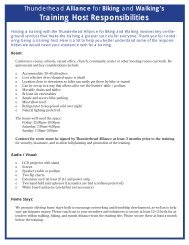2007 Benchmarking Report - Alliance for Biking & Walking
2007 Benchmarking Report - Alliance for Biking & Walking
2007 Benchmarking Report - Alliance for Biking & Walking
You also want an ePaper? Increase the reach of your titles
YUMPU automatically turns print PDFs into web optimized ePapers that Google loves.
Bicycling & <strong>Walking</strong> in the U.S./ Thunderhead <strong>Alliance</strong> <strong>2007</strong><br />
54<br />
BICYCLING & WALKING POLICIES & PROVISIONS<br />
PHOTO COURTESY OF HO JOHN LEE<br />
Safe Routes to School: A Look at the Newest Funding Source<br />
Winning Safe Routes to School in the U.S.<br />
The term “Safe Routes to School” (SRTS) was coined<br />
in the 1970s in Denmark as part of an initiative to reduce the<br />
number of children killed while biking and walking to school.<br />
The term spread internationally reaching Bronx, NY in 1997<br />
when the first Safe Routes to School program began in the U.S.<br />
In 1998 Congress funded pilot Safe Routes to School programs<br />
in Arlington, Massachusetts and Marin County, Cali<strong>for</strong>nia. The<br />
Safe Routes to School buzz continued to spread to communities<br />
developing their own grassroots programs throughout the<br />
U.S.. Thunderhead <strong>Alliance</strong> member organizations lobbied<br />
Congress from 2002-2005 <strong>for</strong> a federally-funded Safe Routes to<br />
School program. Some already had local programs underway<br />
which would later become model programs. In 2005, Congress<br />
voted to include a federally-funded National Safe Routes to<br />
School Program as part of SAFETEA-LU, the reauthorization<br />
bill <strong>for</strong> the federal transportation law. This victory <strong>for</strong> Thunderhead’s<br />
coalition is now being celebrated nationwide as states<br />
have begun to coordinate their programs, in many cases with<br />
the help of Thunderhead organizations providing their expertise<br />
and resources.<br />
An Early Look at SRTS Programing<br />
The National Safe Routes to School program will be<br />
about two-years old when this report is released. At the time of<br />
this project’s data collection it was just over one year old. Although<br />
it is important to begin collecting data on the program<br />
in 50 states, there is a limited amount of in<strong>for</strong>mation available<br />
at this time since many states are still organizing their programs<br />
and some have yet to spend any of their Safe Routes to School<br />
funding. For this report, states were asked about levels of funding,<br />
allocation of funds between capital projects and education<br />
programs, and staffing levels. They were also encouraged to<br />
include other DOT funding spent on the program. Findings<br />
indicate that states are varied among their approaches to the<br />
programming of Safe Routes to School funding. While states<br />
average one full-time-equivalent staff person dedicated to the<br />
program, some states are taking creative approaches to increasing<br />
their staff capacity, such as using Americorps volunteers to<br />
help with messaging and promotion, or relying on field coordinators<br />
in each school district <strong>for</strong> outreach to schools. States also<br />
vary in their allocation of funds to capital projects vs education<br />
projects, although variation is restricted by legislation.



